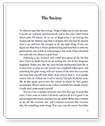Essay Instructions: The Purpose
This is your last semester with the School of Biomedical Sciences, and it is important to us that you go onto
your careers with curiosity and a commitment to lifeâ€long learning. Our understanding of the physiological,
pathological and pharmacological mechanisms underlying the cases you will see in people every day will
deepen, be adjusted, and in some cases be radically transformed over your lifetime. It is important that you
keep up with these developments, remain critical and demand evidenceâ€based explanations so you can
play an active role in the continuous improvement of your profession. Therefore, this task and the
associated criteria rubric have been designed with the primary aims of facilitating your curiosity, helping
you to see mechanisms in real situations, and practicing your skills in critical reflection.
For this task you are free to choose any topic which involves the physiology, pathology or pharmacology of
the respiratory system because we want you to investigate something of interest to you. This task focuses
on case studies because this form of primary peerâ€reviewed article provides real illustrations of the
underlying mechanisms in people. The written submission includes sections for describing and evaluating
the underlying mechanisms because we want to you to be able to see the mechanisms in action in real life
situations and we want you to question the completeness and certainty of these models of our
understanding of how the body and drugs function. Finally, the task requires you to provide a thoughtful
recommendation for why the particular case study you have chosen would be interesting, and of use, to
your colleagues because it is not only important for you to remain on a quest for lifelong learning, but that
you foster this curiosity in others in your profession.
The Task and Presentation
Choose one case study which focuses on a topic of respiratory physiology, pathology AND/OR
pharmacology that is of interest to you. Use the following subheadings to structure your presentation of
this case study:
Description of Case: provide a succinct description (no more than 100 words) of the person/people at the
centre of the case study (this will include number of people, age, gender and relevant information about
their health) and of the clinical features of their presentation, changes during care, and outcomes.
Outline of mechanisms: provide a concise, but detailed, explanation of the physiological, pathological
AND/OR pharmacological mechanisms that you believe underlie an important aspect of the case. This will
involve summarising the mechanisms detailed in the chosen paper, but in many instances, will also involve
supplementing this information with additional mechanistic steps from additional sources. Where this is
necessary, the additional sources must be cited using the Harvard referencing style.
Critical evaluation of mechanisms: provide a short critique of the mechanisms presented in the chosen
paper, including how complete and detailed you found the mechanisms to be, whether the mechanisms
were well established (and even, assumed) or were provided as a set of potential alternative models and
how well evidenced these were with additional literature. Also, provide judgements on the degree of
certainty for the involvement of these mechanisms in the case from the author’s perspective, and from
your perspective as the reader.
Recommendation: finally, provide a brief (no more than 100 words) persuasive argument, linked to the
above information, for why you believe that your colleagues would benefit from reading the case study
paper you have chosen.
Reference for case study: at the end, provide the full citation for your chosen case study paper.
Additional References: where is has been necessary to supplement the description of the mechanisms
with additional sources, these should be cited in text where appropriate and then listed at the end, using
Harvard style.
The overall length should be no longer than a single page. An additional page may be used for
additional references if required. These additional references should be cited in the text and listed at the
end of the assignment using Harvard style.
Your assignment must be A4, 1.15 to 1.5 line spacing, with at least 2 cm margins and in 12 point font.


